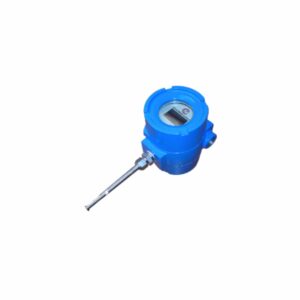Explosion Proof Insertion Thermal Meters
ATMF-IS
| Process Connections: | Threaded, Flanged, Ball Valve |
| Process temperature: | 32 to 851 °F (0 to +455°C) |
| Operating pressure: | 1000 PSIG (69 barg) |
| Velocity Range: | 0.23 to 665 feet/second (0.07 to 203 normal meters per second) |
| Accuracy (and linearity): | ±[1% of Reading + (.5% FS)] ± 0.2% of Full Scale |
| Repeatability: | ± 0.25% of Full Scale |
| Flow units: | Kg/hr, Kg/mn, Kg/s Lbhr, Lb/m Lb/s, NCMH, SCFM, NLPM, SLPM, Mt/s, F/mn, BTU/Hr, BTU/min |
| Turn down ratio: | Over 100:1 |
| Gas pressure effect: | Minor; < ±20% of calibration pressure |
| Material : | 316SS as per DIN 1.4571 (AISI 316 Ti) |
| Gas temperature effect: | 0.01% /° C |
| Response Time: | Less than one second |
| Housing Protection: | NEMA 4,Class 1, Div 1, Groups B, C, & D |
| Weight: | Integral Ex proof: 8.8 lbs (4.0 kg)Remote Ex proof: 15.4 lbs (7.0 kg)Integral Non-Ex proof: 3.3 lbs (1.5 kg)Remote Non Ex proof: 6.6 lbs (3.0 kg) |
| Display Parameters: | Flow, Total flow, Switch settings, Temperature, Elapsed time |
| Signal Interface: | RS232 & RS485, MODBUS |
| Ex-protection: | II 2 GD EEx d IIC T2 or T3 |
| Cable (remote version): | 300 meters |
| Wetted materials: | SS #316 (Hastelloy and Monel optional) |
Product Files
Extra Images

Atmfis-nh flow meter Click image to enlarge
SMC’s insertion mass Flowmeters are thermal dispersion type, utilizing the constant temperature difference method of measuring Gas Mass Flow Rate. It contains two reference grade platinum RTD sensors clad in a protective 316 SS sheath. Its’ features include direct mass flow measurement for gases, wide range-ability, low pressure drop, excellent low end sensitivity, and no moving parts. The SMC ATMF series is microprocessor-based and does not have any potentiometers. Electronics can be integral style, or remote mount with a rugged, windowed dual compartment enclosure for local or remote displays. Four models are available from the low-cost blind meters to the more exotic featured SP models.
Calibration Self Check: The flowmeter has built in diagnostics – a display of the calibration milliwatts (mw) can be used to check the sensor’s operation by being compared to the original reported “zero flow” value noted on meter’s Certificate of Conformance (last few lines) and metallic tag. This convenient in-situ field diagnostic procedure verifies that the original factory calibration hasn’t drifted, shifted, or changed. This “Sensor Functionality and Zero Self Check” also verifies that the sensor is free from contamination, even without inspection.


